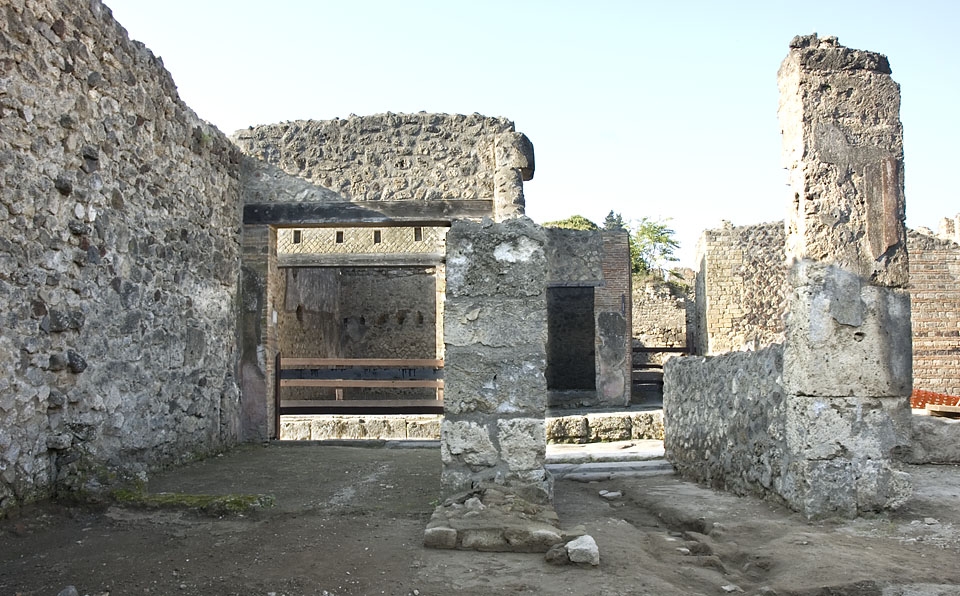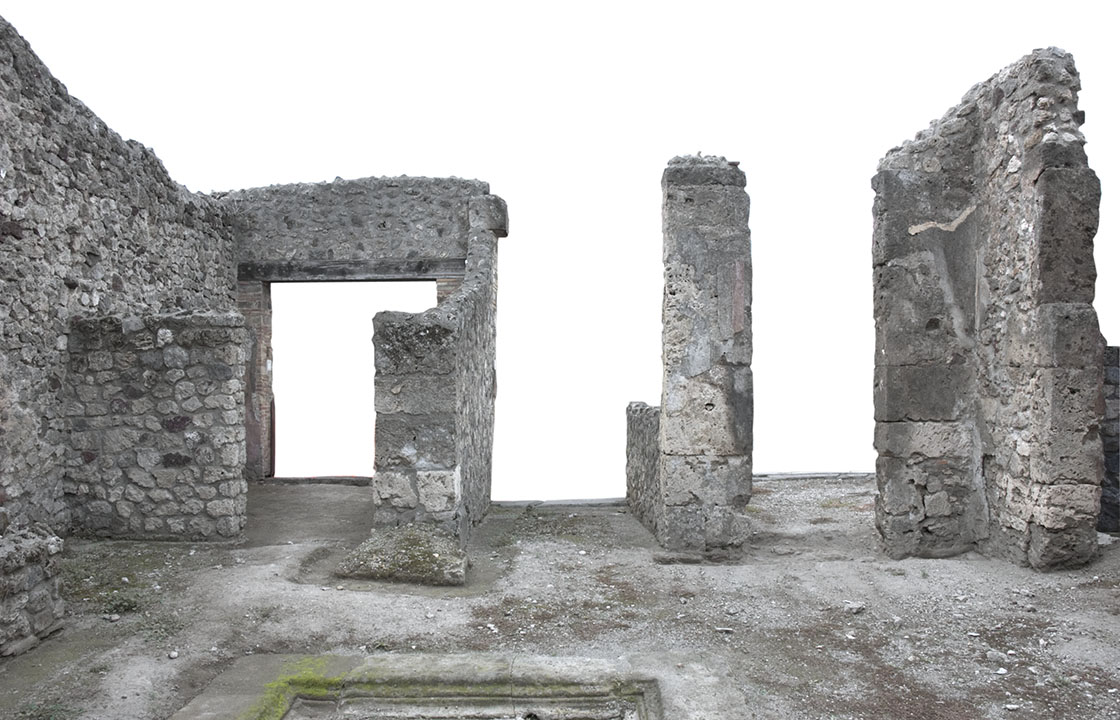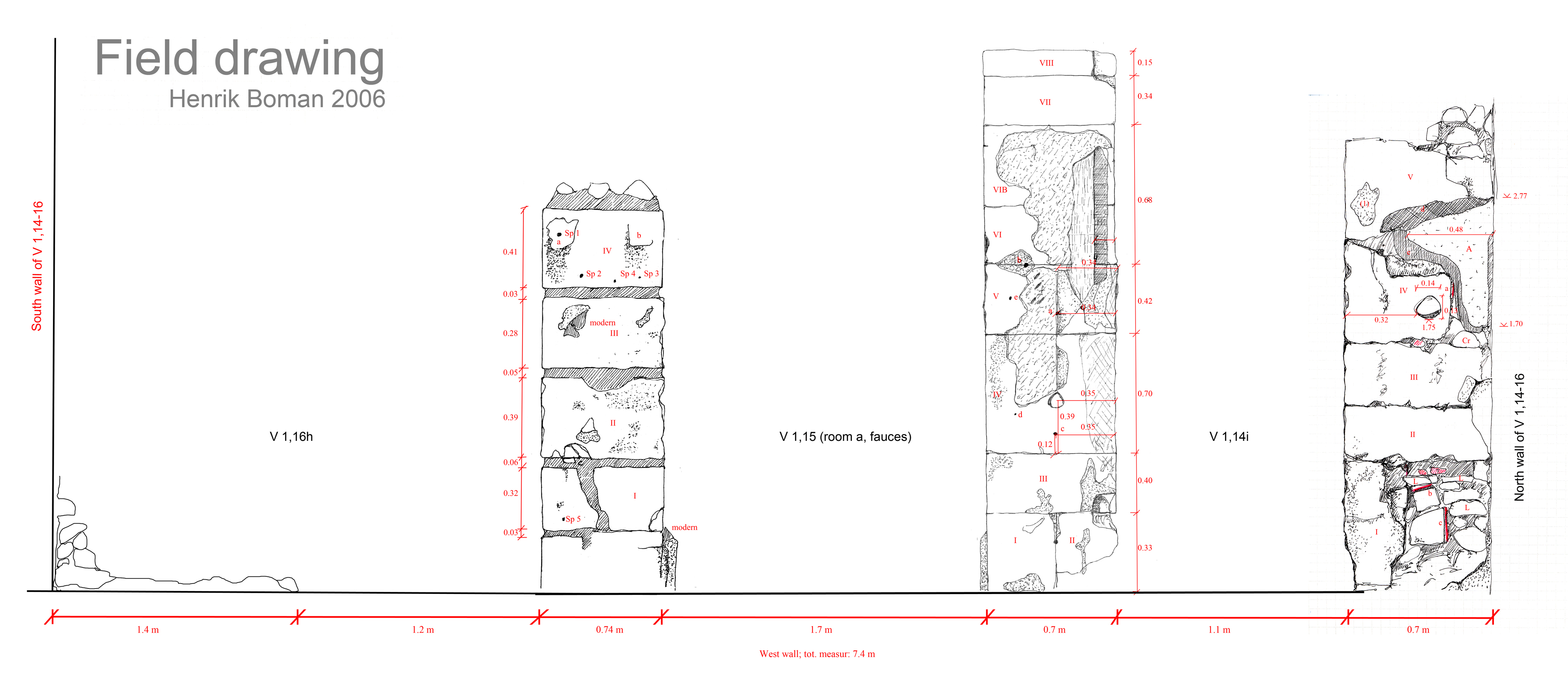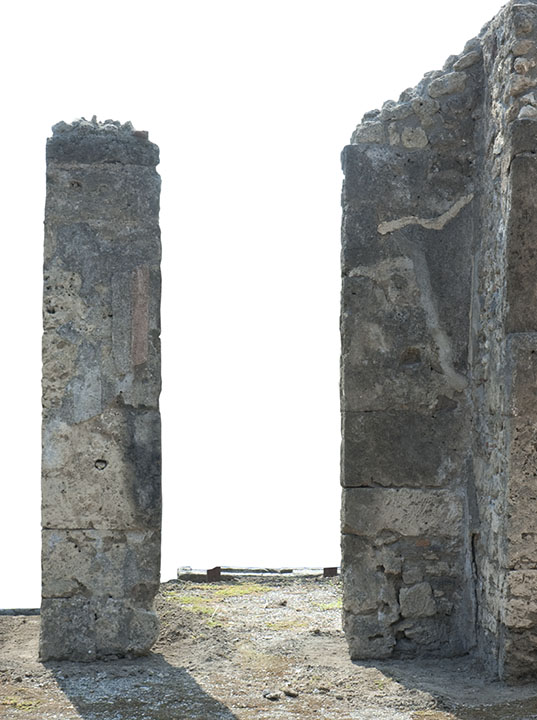West Wall
Description
Henrik Boman & Monika Nilsson
The wall is characterized by its three doorways to rooms V 1,14i, a (fauces) and V 1,16h. The wall is therefore divided into four sections by the doors, here labelled Atrium West Wall (AWW) 1-4 from N to S.
The larger part of the wall, specifically the sections on both sides of room a (fauces), is built with ashlar blocks. The southern part of the wall (AWW 4), by room V 1,16h, is today completely destroyed and it was reconstructed in 2008. Prior to the restoration, only the lower stones were visible above floor level and there are indications that the wall has been completely re-erected and then destroyed once again in modern times.
Northern part of west wall — NW corner - AWW 1
This wall section is built with limestone ashlar blocks (I-V), but for the lower part smaller blocks with several spoils (Sp) have been used.
Wall between V 1,15 (room a, fauces) and V 1, 14i - AWW 2
The wall is constructed with massive limestone blocks (I-VIII). Two are split vertically (I-II); the others are well cut blocks with fine joints, extending the width of the wall. Traces of modern restoration (mortar) are visible in the joints on the lower stones (I-III), while the ancient mortar (plaster?) is still visible between the upper stones (VII-VIII).
Wall between V 1,15 (room a, fauces) and V 1, 16h - AWW 3
The wall is built with large limestone blocks with thick joints of modern mortar (0.03-0.06m) indicating restorations, perhaps after the severe damage caused by the 1943 bombings or the 1980 earthquake — the restoration is fairly modern, though prior to 2000.
S part by V 1, 16h - AWW 4
This wall is thoroughly destroyed and only the foundations of the wall are visible at floor level. A few plaster fragments preserved in the corner indicate that the wall did not bind to the S wall of the house (see E wall in V 1,16h). There are stones projecting from the S wall, at a higher level than the remains of AWW 4 and, although they appear to be bounding stones, they are most likely modern reconstructions prior to 2000. The same type of arrangement is visible in the modern wall above the door to tavern V 1,17.
In 2008 the wall was reconstructed.
AWW 1: Northern part of west wall — NW corner
This wall section is built with limestone ashlar blocks (I-V), but for the lower part where smaller blocks with several spoils (Sp) have been used.
Legend to Field Drawing 2006
a: spoil, block IV, h: 1.9m
b: spoil, on tufa block, h: 0.58m
c: spoil, on lime stone block, h: 0.36 — 0.47m
d: modern mending plaster, yellow
e: modern mending plaster, grey
Measurements:
I: H: 0.74m; W: 0.34m
II: H: 0.28m; W: 0.70m (min)
III: H: 0.44m; W: 0.81m (min)
IV: H: 0.8m; W: 0.52m V: H: 0.75m; W: 0.47m (min)
I. Eroded limestone block with several cavities and remains of plaster; it is difficult to judge whether this is one cracked block or several stones. The stone extends all the way through the wall and into room V 1,14i.
II. A well-cut block, with a cutting towards the door, also traceable in the blocks below but not in the blocks above. The block is massive and extends through the wall.
III. As block II, it is well-cut and extends through the wall.
IV. A large block, with a roughly cut upper side and remains of plaster on at least one surface not facing outwards. The block does not extent to the NW corner; this part of the wall is instead constructed with smaller limestone and cruma stones, and large quantities of mortar, partly covered by the preserved plaster. A round cavity (diam: 0.13m), presumably cut, since the edges are smooth, is seen at a height of 1.75m. The plaster found inside the hole and the on the side of the block (a), indicate that the block is a spoil and the round cutting might have filled a purpose at the block’s previous location.
V. Irregularly cut (fragmented?) limestone, with an outward facing plaster surface (1) possibly from an earlier phase. The top surface of the block might have been intended for the door lintel, approx. at a height of 3m from floor level.
The upper part of the wall is in a bad state of preservation, with several blocks missing, and the full height of the wall is therefore difficult to calculate. There are no traces of a superstructure, like an upper floor, or roof construction.
Plaster: There are no traces of the decoration. The plaster holds a high degree of crushed terracotta, which might indicate that the ground color was red, confirming what Mau described as red walls in 1877. One smaller patch of plaster is found by the floor in the NW corner, and along the corner between the walls modern protective plaster is visible.
Two different types of ancient plaster are found on this wall: one with a dominating white paste, with black and red particles, and a second where the black particles dominate. Several modern attachment nails are found, as well as protective plaster, around the egdes of the ancient plaster .
Two different modern protective plasters are found by the large plaster area (A): a yellow (d) along the upper edge of the plaster, and a grey (e) by the lower. The plaster was presumably better preserved below this large area, as indicated by the earlier yellow protective plaster, which is found only at the upper edge. The later grey plaster was applied after the ancient plaster on the lower part of the wall had fallen. We do not know to what extent the plaster was preserved when the house was excavated. The max. height of plaster is today 2.8m.
AWW 2: Wall between V 1,15 (room a, fauces) and V 1,14i
The wall is constructed with massive limestone blocks (I-VIII). Two are split vertically (I-II); the others are well cut blocks with fine joints, extending the width of the wall. Traces of modern restoration (mortar) are visible in the joints on the lower stones (I-III), while the ancient mortar (plaster?) is still visible between the upper stones (VII-VIII).
Legend to Field Drawing 2006
All stone have the same width: 0.7m
I: H: 0.33m
II: H: 0.33m
III: H: 0.40m
IV: H: 0.70m
V: H: 0.42m
VI (A+B) : H: 0.68m
VII: H: 0.34m
VIII: H: 0.15m
a. Hole from an iron nail (?), height over floor 1.63m, located in the centre of the stone: possibly a modern attachment nail for plaster. A vertical line is clearly visible in the large plastered area on the central part of the wall, in orientation with the iron nail — the reason for this is unknown; could it be the remains of a pilaster decorating the door frame to/from fauces?
b. Hole of the same type as (a), presumably drilled - located at a height of 2.0m.
c. Nail at a height of 0.95m, centrally located, as (a).
d. Modern nail (attachment nail?)
e. Cavity
Larger areas of plaster extend over the joints of the stones, indicating that the wall has been standing and was not severally damaged in the WW II bombings. Only the rough underlying plaster is preserved.
The well-defined straight line (today filled with modern mending plaster) of the plaster layer towards the N doorframe shows that wooden frames (approx. 0.17m wide) were used in the door opening. No threshold was found in the door opening to V 1,14i; the marble slab lying in the door opening when we started the documentation being of modern origin.
The earth under the marble slab was extremely loose and we assume that the ancient filling in the area was removed or disturbed in modern times.
There are no traces of a similar wooden frame around the door opening to room a (fauces). The plaster along the doorframe to fauces extends over the frame, and the preserved floor might suggest that there was no threshold in this door opening. The preserved plaster pilaster on the S wall of fauces (no traces on the north wall are visible) suggests different arrangements and appearances of the doors in the west wall.
Door post to V 1,14i: All blocks of AWW 2 extend into room V 14i.
AWW 3: Wall between V 1,15 (room a, fauces) and V 1,16h
The wall is built with large limestone blocks with thick joints of modern mortar (0.03-0.06m) indicating restorations, perhaps after the severe damage caused by the 1943 bombings or the 1980 earthquake — the restoration is fairly modern, though prior to 2000.
Legend to Field Drawing 2006
Sp 1: Iron nail, to attach now destroyed plaster.
Sp 2-4: Cavities or traces of iron nails (modern?).
Sp 5: Iron nail, modern attachment nail.
a: Area with plaster.
b: Area where plaster (recently?, prior to 2000) has fallen down.
c: Tiles incased in modern mortar.
There are fragments of plaster on the individual blocks, though no areas extend over the joints. Modern protective plaster is found at a level of 1.2 -1.3m (on block III), indicating the height of the plaster as found after the excavations. At floor level, on the S wall of fauces, close to the door opening to the atrium, the remains of a plaster pilaster are preserved.
In the northern door post to V 1,16 all blocks are c. 0.38m wide. The blocks extend to the S wall of the fauces, where the edges are more irregular than in the door post to V 1,16. Large quantities of modern mortar are found in the joints, indicating that the wall, at least on one occasion, has been completely destroyed (see also V 1,16h, N wall and V 1,15a, S wall).
AWW 4: S part by V 1, 16
This wall is thoroughly destroyed and only the foundations of the wall are visible at floor level. A few plaster fragments preserved in the corner indicate that the wall did not bind to the S wall of the house (see E wall in V 1,16h). There are stones projecting from the S wall, at a higher level than the remains of AWW 4 and, although they appear to be bounding stones, they are most likely modern reconstructions prior to 2000. The same type of arrangement is visible in the modern wall above the door to tavern V 1,17.
In 2008 the wall was reconstructed.
The wall has a large block, c. 0.85m in length (minimum), visible just at floor level before the 2008 restorations.
L: 7.43m
Max. H: 4m (NW corner)
Min. H: 0.1m (S by door to room V 1,16h)
Door to V 1,14i: W: 1.08 m
Door to fauces: W: 1.68m
Door to V 1,16h: W: 1.22m





